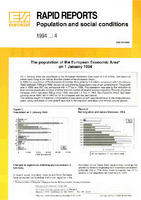| dc.description.abstract | On 1 January 1994 the population of the European Economic Area stood at 375 million, 349 million of whom were living in the twelve Member States of the European Union. In 1993 the population of the European Economic Area grew by 1.5 million, compared with 1.9 million in 1992. Between 1984 and 1992, the growth rate of the EEA population was on an upward trend. The growth rate in 1993 was 3.9°/oo, compared with 4.7°/oo in 1992. This slowdown was due to the reduction in both natural growth (the number of births less the number of deaths) and net migration. The rate of natural increase, which has been falling since 1990, was just 1.1 °/oo in 1993. Net migration, which had been growing since 1984, fell In 1993 by 12 % compared with the year before. The relative weight of these two components of population growth was the same as in the three previous years: about two thirds of total growth was due to net migration and about one third to natural growth. |

